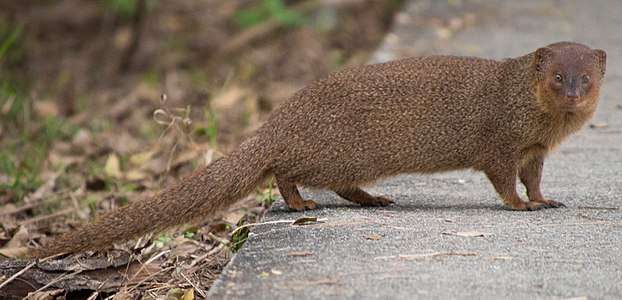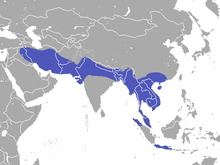Javan mongoose
| Javan mongoose | |
|---|---|
 | |
| Scientific classification | |
| Kingdom: | Animalia |
| Phylum: | Chordata |
| Class: | Mammalia |
| Order: | Carnivora |
| Family: | Herpestidae |
| Genus: | Herpestes |
| Species: | H. javanicus |
| Binomial name | |
| Herpestes javanicus (É. Geoffroy Saint-Hilaire, 1818) | |
| Subspecies | |
|
H. j. javanicus | |
 | |
| Javan mongoose range | |
The Javan mongoose (Herpestes javanicus) is a species of mongoose found in the wild in South and Southeast Asia. It has also been introduced to Hawaii, the Bahamas, Cuba, Croatia, Jamaica, Hispaniola, Puerto Rico, the Lesser Antilles, Belize, Honduras, Panama, Trinidad and Tobago, Colombia, Suriname, Venezuela, Guyana and Mafia Island.[2] The western subspecies group is sometimes treated as a separate species, the Indian mongoose or small Indian mongoose (Herpestes auropunctatus).[3]
Description
This species of mongoose is sympatric with Herpestes edwardsii in much of its native range and can be readily distinguished from the latter species by its much smaller size. The body is slender and the head is elongated with a pointed snout. The length of the head and body is 509–671 millimetres (20.0–26.4 in). The ears are short. They have five toed feet with long claws. Genders differ in size with males having a wider head and bigger bodies.[4]
They use about 12 different vocalizations.[5]
Habitat
Currently, there isn’t a study that has determined the preferred habitat for the Javan mongoose in its native range, however observations of trap success of the animal provides some insight .[6] In studies where traps were used in an attempt to remove the mongoose, it was found that the trap success was nearly zero in conditions of rain.[7] This information, along with other reports of the Javan mongoose’s strong dislike for rain, suggests that the mongoose prefers very dry habitats.[6]
There are studies that note the preferred habitats of the Javan mongooses introduced to other places such as Thailand, the Caribbean islands, Hawai’i, and Nepal. However, these preferences vary and do not provide information regarding the mongoose in its natural habitat.[6]
Subspecies
- H. j. javanicus
- H. j. auropunctatus
- H. j. exilis
- H. j. orientalis
- H. j. pallipes
- H. j. palustris (Bengal mongoose)
- H. j. peninsulae
- H. j. perakensis
- H. j. rafflesii
- H. j. rubrifrons
- H. j. siamensis
- H. j. tjerapai
Diet
These mongoose mostly eat insects but are opportunistic feeders and will eat crabs, frogs, spiders, scorpions, snakes, small mammals, birds and eggs.
Behavior and reproduction
Mongooses are mostly solitary although males will sometimes form social groups and share burrows. Pregnancy duration is up to 49 days. A litter can consist of 2–5 young.
Introduction to Hawaii
The 1800s was a huge century for sugar cane, and plantations shot up on many tropical islands including Hawaii, Fiji and Jamaica. With sugar cane came rats, attracted to the sweet plant, which ended up causing crop destruction and loss. Attempts were made to introduce the species in Trinidad in 1870, but this failed.[8] A subsequent trial with four males and five females from Calcutta however, were established in Jamaica in 1872. A paper published by W. B. Espeut that praised the results intrigued Hawaiian plantation owners who, in 1883, brought 72 mongooses from Jamaica to the Hamakua Coast on the Big Island. These were raised and their offspring were shipped to plantations on other islands.[9] Populations that have been introduced to these islands show larger range sizes than in their native ranges.[10] They also show genetic diversification due to drift and population isolation.[11]
Only the islands of Lana'i and Kaua'i are thought to be free of mongooses. There are two conflicting stories of why Kaua'i was spared. The first is that the residents of Kaua'i were opposed to having the animals on the island and when the ship carrying the offspring reached Kaua'i, the animals were thrown overboard and drowned. A second story tells that on arriving on Kaua'i one of the mongooses bit a dockworker who, in a fit of anger, threw the caged animals into the harbor to drown. [12]
Accounts from the sugar industry in the early 20th century state that the introduced mongooses were effective at significantly reducing the number of rats, mice, and insects.[13]
Introduction to Caribbean
Starting in 1870, the Javan mongoose was introduced to Jamaica, Cuba, Hispaniola, St. Croix (1884), to prey upon black rats (Rattus rattus) that were ravaging the sugarcane industry. While very successful in reducing sugarcane damage from rats, the introduction had a negative impact on reptiles and other animals. For instance, the solenodons were almost made extinct. The Green iguana (Iguana iguana) has been greatly reduced in number and the St. Croix ground lizard (Ameiva polops) was eliminated from the island of St. Croix (but not from Protestant Cay, Green Cay, Ruth Cay, and Buck Island) before 1962. Ground nesting birds have also been greatly affected. Mongooses have even preyed upon fawns of white-tailed deer (Odocoileus virginianus). Because of the negative effect on other animals, the United States and other countries in the Americas banned importing live mongoose.[14][15]
Introduction to Okinawa
The mongoose was introduced onto Okinawa Island in 1910 and Amami Ōshima Island in 1979 in an attempt to control the population of Habu (Trimeresurus flavoviridis, 波布) and other pests; an invasive species, they have since become pests themselves.[16][17] The efficacy of the mongoose against the habu population was quite limited however, since the mongoose is a diurnal creature and the habu are nocturnal. As such, they didn't encounter each other as often as had been desired.[18]
Invasive species
Most reports claim that the mongoose introduction did not have the desired effect of rat control, either in Hawaii or St. Croix (This may be because rats are nocturnal and mongooses aren't). The mongoose hunted birds and bird eggs, threatening many local island species. The mongooses bred prolifically with males becoming sexually mature at 4 months and females producing litters of 2–5 pups a year. On Okinawa, the mongoose is known to carry antimicrobial-resistant strains of E. coli.[19]
Mongooses can carry leptospirosis,[20] and are a major rabies vector in Puerto Rico.[21]
In 2016, the European Commission put the mongoose on the list of invasive alien species in the EU.[22]
References
- ↑ Wozencraft, C.; Duckworth, J.W.; Choudury, A.; Muddapa, D.; Yonzon, P.; Kanchanasaka, B.; Jennings A. & Veron, G. (2008). "Herpestes javanicus". IUCN Red List of Threatened Species. Version 2008. International Union for Conservation of Nature. Retrieved 22 March 2009. Database entry includes a brief justification of why this species is of least concern.
- ↑ LONG JL 2003. Introduced Mammals of the World: Their History, Distribution and Influence (Cabi Publishing) by John L. Long ( ISBN 9780851997483)
- ↑ Patou, M. L., Mclenachan, P. A., Morley, C. G., Couloux, A., Jennings, A. P., & Veron, G. (2009). Molecular phylogeny of the Herpestidae (Mammalia, Carnivora) with a special emphasis on the Asian Herpestes. Molecular Phylogenetics and Evolution, 53(1), 69-80.
- ↑ Nellis, D. W (1989). "Herpestes auropunctatus. Mammalian species". 342. American Society of Mammalogists/Oxford University Press: 1–6 – via Oxford Academic.
- ↑ Mulligan, B E and D W Nellis (1973) Sounds of the Mongoose Herpestes auropunctatus. J. Acoust. Soc. Am. 54(1):320-320
- 1 2 3 Hays, Warren ST, and Sheila Conant. "Biology and impacts of Pacific Island invasive species. 1. A worldwide review of effects of the small Indian mongoose, Herpestes javanicus (Carnivora: Herpestidae)." Pacific Science 61.1 (2007): 3-16.
- ↑ Nellis, D. W., and C. O. R. Everard. 1983. The biology of the mongoose in the Ca- ribbean. Stud. Fauna Curacao Other Ca- ribb. Isl. 195:1–162.
- ↑ Hoagland, D. B., G. R. Horst, and C. W. Kilpatrick (1989) Biogeography and population biology of the mongoose in the West Indies. Pages 611–634 in C. A. Woods, editor. Biogeography of the West Indies. Sand Hill Crane Press, Gainesville, Florida, USA.
- ↑ Espeut, W. B. 1882. On the acclimatization of the Indian mongoose in Jamaica. Proceedings of the Zoological Society of London 1882:712–714.
- ↑ Simberloff, D.; T. Dayan; C. Jones; Go Ogura (2000). "Character displacement and release in the small Indian mongoose, Herpestes javanicus" (PDF). Ecology. Ecological Society of America. 81 (8): 2086–2099. doi:10.2307/177098.
- ↑ Carl-Gustaf Thulin; Daniel Simberloff; Arijana Barun; Gary McCracken; Michel Pascal; M. Anwarul Islam (2006). "Genetic divergence in the small Indian mongoose (Herpestes auropunctatus), a widely distributed invasive species". Molecular Ecology. 15 (13): 3947–3956. doi:10.1111/j.1365-294X.2006.03084.x. PMID 17054495.
- ↑ "Hawaiian Creatures - Small Asian Mongoose". www.instanthawaii.com. Retrieved 8 May 2018.
- ↑ Kim, Alice. "Mongooses in Hawaii Newspapers". University of Hawai'i at Manoa Library. Retrieved 22 December 2015.
- ↑ Ley, Willy (December 1964). "The Rarest Animals". For Your Information. Galaxy Science Fiction. pp. 94–103.
- ↑ George A. Seaman; John E. Randall (1962). "The Mongoose as a Predator in the Virgin Islands". Journal of Mammalogy. American Society of Mammalogists. 43 (4): 544–546. doi:10.2307/1376922. JSTOR 1376922.
- ↑ "The Small Asian Mongoose introduced to the Island of Okinawa and Amami-Oshima: The Impact and Control Measure." Science Links Japan. Accessed 15 Feb 2009.
- ↑ Fisher, Cindy. Marines defend Camp Gonsalves from encroaching mongoose 9 July 2006. Stars and Stripes. Accessed 15 Feb 2009.
- ↑ okinawanaturephotography.com
- ↑ Nakamura, Ichiro; Obi, Takeshi; Sakemi, Yoko (August 2011). "The Prevalence of Antimicrobial-Resistant Escherichia coli in Two Species of Invasive Alien Mammals in Japan". JOURNAL OF VETERINARY MEDICAL SCIENCE. 73 (8): 1067–1070. doi:10.1292/jvms.10-0525. PMID 21467758.
- ↑ Ishibashi Osamu ; Ahagon Ayako ; Nakamura Masaji ; Morine Nobuya ; Taira Katsuya ; Ogura Go ; Nakachi Manabu ; Kawashima Yoshitsugu ; Nakada Tadashi (2006) Distribution of Leptospira Spp. on the Small Asian Mongoose and the Roof Rat Inhabiting the Northern Part of Okinawa Island. Japanese Journal of Zoo and Wildlife Medicine 11(1):35–41
- ↑ "Distribution of major rabies virus variants among mesocarnivores in the United States and Puerto Rico, 2008 to 2015".
- ↑ "Adopting a list of invasive alien species of Union concern pursuant to Regulation (EU) No 1143/2014 of the European Parliament and of the Council" (PDF).
External links
| Wikispecies has information related to Herpestes javanicus |
| Wikimedia Commons has media related to Herpestes javanicus. |
Further reading
Tseng, Zhijie; Flynn, John (January 2015). "Convergence analysis of a finite element skull model of Herpestes javanicus (Carnivora, Mammalia): Implications for robust comparative inferences of biomechanical function". Journal of Theoretical Biology. 365: 112–148. doi:10.1016/j.jtbi.2014.10.002. PMID 25445190.
